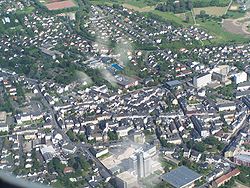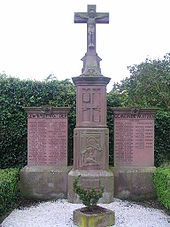
The Eifel is a low mountain range in western Germany, eastern Belgium and northern Luxembourg. It occupies parts of southwestern North Rhine-Westphalia, northwestern Rhineland-Palatinate and the southern area of the German-speaking Community of Belgium.
The Eifelkreis Bitburg-Prüm is a district in Rhineland-Palatinate, Germany. It is bounded by Luxembourg, Belgium and the districts of Euskirchen, Vulkaneifel, Bernkastel-Wittlich and Trier-Saarburg.
Vulkaneifel is a district (Kreis) in the northwest of the state Rhineland-Palatinate, Germany. It is the least densely populated district in the state and the fourth most sparsely populated district in Germany. The administrative centre of the district is in Daun. Neighboring districts are Euskirchen, Ahrweiler, Mayen-Koblenz, Cochem-Zell, Bernkastel-Wittlich, and Bitburg-Prüm.

Oberkail is a municipality in the rural area of Eifel in Rhineland-Palatinate in the administrative district Bitburg-Prüm and is part of Verbandsgemeinde Bitburger Land.

Meisburg is an Ortsgemeinde – a municipality belonging to a Verbandsgemeinde, a kind of collective municipality – in the Vulkaneifel district in Rhineland-Palatinate, Germany. It belongs to the Verbandsgemeinde of Daun, whose seat is in the like-named town. In Meisburg, a Moselle Franconian dialect is spoken.
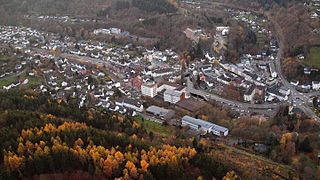
Schleiden is a town in North Rhine-Westphalia, Germany. It lies in the Eifel hills, in the district of Euskirchen, and has 12,998 inhabitants as of 30 June 2017. Schleiden is connected by a tourist railway to Kall, on the Eifel Railway between Cologne and Trier. The town consists of 18 settlements, the largest of which are Gemünd and Schleiden proper.

Speicher is a town in the county of Bitburg-Prüm, in Rhineland-Palatinate, Germany. It is situated in the Eifel, on the river Kyll, approximately 10 km south-east of Bitburg and 29 km north of Trier. It has 3,624 inhabitants and is next to the Spangdahlem Air Base which is home of the 52d Fighter Wing. There is a small monument to the men who died in the First and Second World Wars at the western end of the town. East of the monument is an open area for shopping and other events. Directly to the south is the parish church of St. Philip and St. James.

Aach is a municipality in the German state of Rhineland-Palatinate. It is part of Trier-Land, a Verbandsgemeinde.
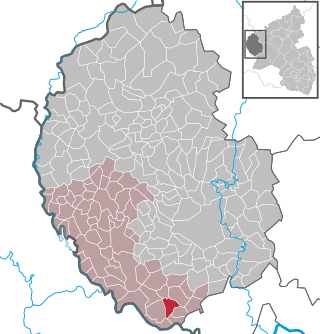
Irrel is a municipality in the district Bitburg-Prüm, in Rhineland-Palatinate, Germany. It is situated in the Eifel, near the border with Luxembourg, at the confluence of the rivers Prüm and Nims. It is located approximately 15 km south-west of Bitburg and 5 km north-east of Echternach.
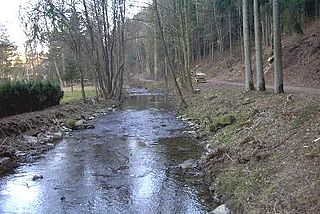
The Nims is a 61-kilometre-long (38 mi), lefthand arm of the River Prüm in the South Eifel region of the Eifel Mountains. It runs through the county of Bitburg-Prüm in the German state of Rhineland-Palatinate.

Landscheid is an Ortsgemeinde – which is a municipality belonging to a Verbandsgemeinde, a kind of collective municipality – in the Bernkastel-Wittlich district of Rhineland-Palatinate, Germany.

Binsfeld near Wittlich in the Eifel is an Ortsgemeinde – a municipality belonging to a Verbandsgemeinde, a kind of collective municipality – in the Bernkastel-Wittlich district in Rhineland-Palatinate, Germany. Nearby is the American Spangdahlem Air Base.

Affler is a municipality in the district of Bitburg-Prüm, in Rhineland-Palatinate, western Germany.
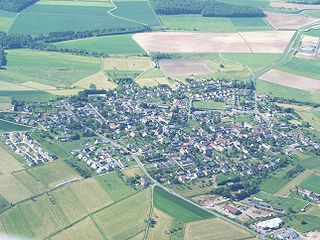
Badem is a municipality in the district of Bitburg-Prüm, in Rhineland-Palatinate, western Germany.

Dockendorf is a municipality in the district of Bitburg-Prüm, in Rhineland-Palatinate, western Germany.

Waxweiler is a municipality in the county of Bitburg-Prüm, in Rhineland-Palatinate, western Germany. It is located in the Eifel, south of Prüm and is accessible through the Autobahn 60. The parish of about 1100 inhabitants lies 345 meters above sea level.

Rockeskyll is an Ortsgemeinde – a municipality belonging to a Verbandsgemeinde, a kind of collective municipality – in the Vulkaneifel district in Rhineland-Palatinate, Germany. It belongs to the Verbandsgemeinde of Gerolstein, whose seat is in the like-named town.

The Trier West Railway a 14 km-long railway line running from Trier-Ehrang in the German state of Rhineland-Palatinate to Wasserbillig in Luxembourg via Trier-West. The double-track, electrified section between Trier-Ehrang and the Moselle bridge at Konz forms a bypass of the Trier rail node.

Bitburg-Erdorf station is a station on the Eifel Railway in Bitburg in the German state of Rhineland-Palatinate. The Nims–Sauer Valley railway (Nims-Sauertalbahn) branched off here to the now closed Bitburg Town station, the remaining part of which is only used for freight traffic and occasional excursion trains. Today Bitburg-Erdorf station is the only station in Bitburg that is served by regular passenger services.

Ehrang station is, after Trier Hauptbahnhof, the second most important station in the city of Trier in the German state of Rhineland-Palatinate. The station forms a railway junction with a former marshalling yard that is still partly used as a freight yard. At the station, the Eifel Railway from Cologne connects with the Koblenz–Trier railway. Until 1983, Ehrang station was also the starting point of the Trier West Railway to Igel that connected with Wasserbillig / Luxembourg.
